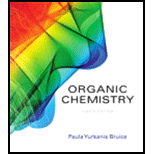
(a)
Interpretation:
Concept Introduction:
Thus,
Increasing the height of the energy barrier decreases the magnitude of the rate constant, thus causes the reaction to be slower.
The rate of the
Steric hindrance decreases the rate of the reaction by increasing the energy of the transition state.
Higher the height of the energy barrier lowers the rate constant.
(b)
Interpretation:
Rate of the reaction of methyl iodide with quinuclidine and methyl iodide with trimethylamine is measured in nitrobenzene, based on it answer the following questions.
Concept Introduction:
Thus,
Increasing the height of the energy barrier decreases the magnitude of the rate constant, thus causes the reaction to be slower.
The rate of the
Steric hindrance decreases the rate of the reaction by increasing the energy of the transition state.
Higher the height of the energy barrier lowers the rate constant.
(c)
Interpretation:
Rate of the reaction of methyl iodide with quinuclidine and methyl iodide with trimethylamine is measured in nitrobenzene, based on it answer the following questions.
Concept Introduction:
Thus,
Increasing the height of the energy barrier decreases the magnitude of the rate constant, thus causes the reaction to be slower.
The rate of the SN2 reaction depends not only on the number of alkyl group but also on the size.
Steric hindrance decreases the rate of the reaction by increasing the energy of the transition state.
Higher the height of the energy barrier lowers the rate constant.
Want to see the full answer?
Check out a sample textbook solution
Chapter 9 Solutions
Organic Chemistry; Organic Chemistry Study Guide A Format: Kit/package/shrinkwrap
- Based on the theoretical result, what is the order of reactivity of primary, secondary, and tertiary alkyl halides with sodium iodide in acetone? Based on the theoretical result, what is the order of reactivity of primary, secondary, and tertiary alkyl halides with ethanolic silver nitrate? In the Silver Nitrate Test, which is more reactive benzyl chloride or chlorobenzene? Compare SN1 and SN2 Reactions of Alkyl Halides ALKYL HALIDESarrow_forwardA nucleophilic addition is not considered SN1 or SN2 because: A.) The reaction proceeds through an E1 mechanism or E2 B.) There is no carbonyl substitution when doing the addition to this C.) The solvent for this reaction is non-aqueous D.) The solvent for this reaction is non-polararrow_forwardIn an E2 reaction, what are the characteristics of a good base? How does a chemist tell a strong versus weak or bulky versus not bulky nucleophile? What is the best type of solvent for this reaction? Please define the terms.arrow_forward
- How does changing the solvent from CH3OH to DMSO affect the rate of an E2 reaction?arrow_forwardDoes doubling the concentration of an alkylhalide and maintaining the alkoxide concentration double the reaction rate? What if the alkylhalide concentration is maintained and the alkoxide concentration is doubled?arrow_forwardWhy aryl bromide is a bad starting material for an electrophilic aromatic substitution? What is different about a nucleophilic aromatic substitution that allows this reagent to be a useful starting material for that reaction?arrow_forward
- Why does the carbomethoxy group directs the reaction to positions that are meta to it ?b) Why the formation of dinitrobenzaote is substantially disfavored ?c) Would you expect small amounts of the ortho and para substituted product ? How would you remove them if they are formed ?d) Why does water have a retarding effect on the nitration ?e) Explain why Benzene has lower reactivity in electrophilic addition reactions than cyclohexene?arrow_forwardHow does solvent affect rate of reaction if its increase or decrease in sn1 or sn2arrow_forwardwhich will proceed more easily at room temperature the bromination of cyclohexene or the bromination of benzene?arrow_forward
- How does increasing base, solvent, or alkyl halide or aptly halide + base affect or decreasing them affect the reaction rate for e2/e1 and sn2/sn1? Please provide examplesarrow_forwardHow does doubling [B:] affect the rate of an E1 reaction?arrow_forwardWhich solvent would be the best choice (DMF, methanol, or acetic acid) to carry out the nucleophilic substitutionreaction between: bromoethane and –CN?arrow_forward
 Organic Chemistry: A Guided InquiryChemistryISBN:9780618974122Author:Andrei StraumanisPublisher:Cengage Learning
Organic Chemistry: A Guided InquiryChemistryISBN:9780618974122Author:Andrei StraumanisPublisher:Cengage Learning
